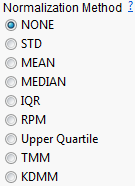Normalization Method
Select a normalization method.

Choices are summarized in the table below. Available choices differ depending on the process.
|
Normalization Method |
Definition |
|||||||||
|
NONE |
|
|||||||||
|
STD |
|
|||||||||
|
MEAN |
|
|||||||||
|
MEDIAN |
|
|||||||||
|
IQR |
|
|||||||||
|
RPM |
|
|||||||||
|
Upper Quartile |
|
|||||||||
|
TMM |
|
|||||||||
|
KDMM |
|
|||||||||
|
Kernel Density Quantile |
|
|||||||||
|
Kernel Density Loess |
|
For more information, refer to the Data Standardize process description.
To Specify a Multiple Testing Method:
| 8 | Click the radio button corresponding to your choice. |